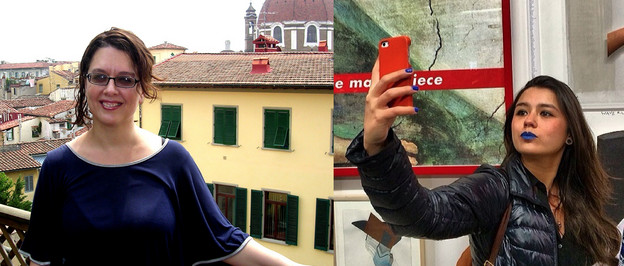
First reading of Sophia Le Fraga's 'W8ING 4' (4)
Kimberly Lamm

Until I looked at Sophia Le Fraga’s “W8ING 4 ![]() ,” I never really thought of seeing the lines of a “text” on a phone as lines of a poem. Since I love the look of poetry, the visual arrangement of words on a page, it seems silly that I didn’t see those parallels until now.
,” I never really thought of seeing the lines of a “text” on a phone as lines of a poem. Since I love the look of poetry, the visual arrangement of words on a page, it seems silly that I didn’t see those parallels until now.
There is a lot to look at in “W8ING 4 ![]() .” The rows of emoji leap out at me with sentimental feeling. They make me think of sticker collections, tiny patterns on cotton dresses, little parts of Joe Brainard paintings. They are buttons, digital and tender.
.” The rows of emoji leap out at me with sentimental feeling. They make me think of sticker collections, tiny patterns on cotton dresses, little parts of Joe Brainard paintings. They are buttons, digital and tender.
The human figure Le Fraga’s texters are waiting for is abstract, grey, and genderless, which means it could represent a man. But the poem the texters create together is animated by a girly liveliness: notes in bubbles, all the “likes,” the instant transmission of intimacy, the slangy surface of their writing, the big-hearted depths. “I was starting to think you/ were gone forever.” “W8ING 4 ![]() ” is the girlification of Godot.
” is the girlification of Godot.
“W8ING 4 ![]() ” goes fast. As the poem unfolded and the letters of the alphabet flashed up before my eyes my attention was sucked into the condensed world of the screen. I was transfixed; it became everything. But almost as quickly, it is the emptiness in and outside the poem, in and outside the texters, in and outside language that compelled me. Mediating between big gaps of emptiness, Le Fraga’s phone is a hand, a typewriter, and a heart.
” goes fast. As the poem unfolded and the letters of the alphabet flashed up before my eyes my attention was sucked into the condensed world of the screen. I was transfixed; it became everything. But almost as quickly, it is the emptiness in and outside the poem, in and outside the texters, in and outside language that compelled me. Mediating between big gaps of emptiness, Le Fraga’s phone is a hand, a typewriter, and a heart.
Once, late at night, I was at a low point in the writing process, brain dead. Words, ideas, and definitions I thought I possessed drifted away as I reached for them. I texted my husband (who teaches philosophy) and asked him a question: “What is metaphysics?” He wrote back: “Being as Presence. Are you okay?” Both my husband and metaphysics were temporarily absent from me, but became slightly more “present” through his textual expression of care. I wish I had kept those texts. No doubt I deleted them into the electronic ether. Are they recoverable?
“W8ING 4 ![]() ” reminded me of this little exchange. The poem moves in the same metaphysical territory. The texters call out for “contacts” and traffic in the desire for presence, a desire both expressed and impeded by language. Though the texters are “there for each other” on screen, something big does not get across. Perhaps the bland silhouette of the human represents that “something” that never arrives.
” reminded me of this little exchange. The poem moves in the same metaphysical territory. The texters call out for “contacts” and traffic in the desire for presence, a desire both expressed and impeded by language. Though the texters are “there for each other” on screen, something big does not get across. Perhaps the bland silhouette of the human represents that “something” that never arrives.
I love the flashing grey ellipses that say: there is writing on the way, there is writing you are about to see.
There’s an assumption floating out there that texting cheapens and truncates language, makes it the opposite of smart, and subservient to the instantaneity of the image. This claim isn’t completely unfounded. But “W8ING 4 ![]() ” is a poem because it makes the writing of texts—in all senses of the word—an opening to reflect upon language, emptiness, and our (failed) relations to others:
” is a poem because it makes the writing of texts—in all senses of the word—an opening to reflect upon language, emptiness, and our (failed) relations to others:
“this being here together at last”
“I guess let’s try and have a/conversation”
“soooooooo/ say something”
“do you”
“do you”
“OMG jinx”
Being together in language is elusive. We are waiting for it to arrive, and it comes — fleetingly — as we write about the fact that it isn’t here.
Kimberly Lamm is currently assistant professor of Women's Studies at Duke University. Her research fields include contemporary feminist art, contemporary poetry, and nineteenth- and twentieth-century US Literature. She is currently completing her first book The Poetics of Address: Writing the Other Woman in Contemporary Art and is looking forward to getting back to a project devoted to contemporary poetry by women, tentatively titled The Sense of Arrangement. Kimberly is a graduate of the Whitney Independent Study Program, has published art criticism in The Brooklyn Rail, curated exhibitions of contemporary art (including Imaginary Arsenals for the Lower Manhattan Cultural Council) and written catalog essays for a number of contemporary artists.